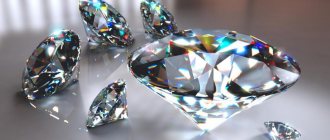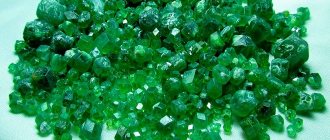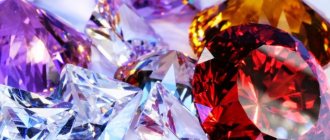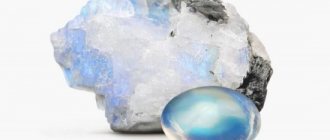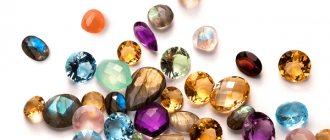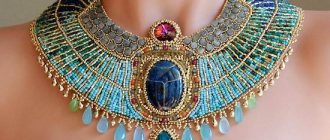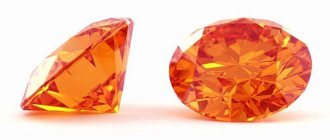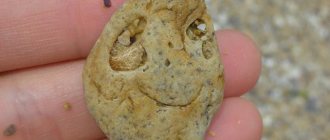An expensive ring with alexandrite has been an object of desire for collectors and fashionistas for several centuries. A ring is an accessory that is chosen for one’s own visual pleasure. At any moment you can glance at your hand and admire a rare mineral that magically changes color from green during the day to red-crimson in artificial light. Alexandrite is chosen by strong-willed and changeable natures. Many people consider imitation alexandrite to be natural because they have never seen the rare gem.
About alexandrite rings of the Soviet period
Jewelry from the USSR period is a clear confirmation of this. Rings with natural alexandrite were not produced at this time.
Since 1973, a limited production of a synthetic analogue has been launched. Rings with grown blue-violet stones that change color were made for the party elite. For the proletariat, jewelry factories produced products with grown corundum.
Fashionable gold rings with alexandrite of those years have become a rarity. The lucky ones inherited accessories of a unique design. Large, spectacular inserts are emphasized by wide polished surfaces of the stone. These jewelry are a symbol of the era, although most of them have synthetic crystals. A huge portion of Soviet rings with natural alexandrites were melted down in the 90s, and the precious inserts were removed.
You can buy a vintage item with an analogue of a gem at a pawnshop. Such decorations have no real value, but are interesting as an exhibit. In order not to buy a remake, you need to know the nuances of jewelry production of past years.
History of the stone
Alexandrite was first found in 1833 in the Urals, mistaking it for an emerald. The thing is that in daylight this stone has a green color. Imagine the surprise of the miners when they later discovered that their “emeralds” had acquired a blood-red hue!
Soon the new stone was identified, studied and even presented to the imperial family. The name of the stone was given in honor of the 16-year-old heir to the throne, Alexander II.
The fashion for alexandrites swept through the capital at breakneck speed. However, only a select few could afford such luxury. After all, both then and now, alexandrite is one of the rarest precious stones. Only members of the royal family and nobles close to them could acquire alexandrite jewelry. In those days, a gold ring with alexandrite was worth a fortune.
Features of old jewelry
Rings were produced stamped, less often cast. The most popular gold standard was 583°, red. For expensive jewelry, 750° yellow gold was used. Affordable products were made from alloys 378° and 500°.
In 1973, the branding rules of 1965 were in effect. The name of the enterprise that produced the jewelry was placed on the bottom of the shank of the ring or ring. To the right of the nameplate is an assay office mark in the form of a spatula. The stamp depicts a star with a hammer and sickle inside, an assay code and a digital expression of the hallmark. Since 1989, a stamp with the image of a boat has been introduced for products for export.
A specialist can examine the parts with a magnifying glass, identify the manufacturer, and the years of manufacture.
It is impossible for the average person to distinguish corundum from natural or synthetic alexandrite. The origin of the insert in the product will be determined by a gemologist. We wrote about this in detail in the article “Real alexandrites: how to distinguish natural stone from imitation.”
Artificial alexandrite
Synthetic alexandrite. The stones sold in jewelry before 1973 under the guise of alexandrite were varieties of synthetic spinel and synthetic corundum with vanadium additives. Many synthetic alexandrites are actually either synthetic corundums, colored with vanadium and having a purplish color that turns redder under artificial light, or synthetic spinels, which have a deeper green color. In 1973, products with synthetic alexandrites appeared on the market, which also have a spectacular color change, but from purple-blue to pink, rather than from green to red.
Technologies for growing alexandrites (close to natural ones) are complex and expensive, so the price of synthetic alexandrites is such that they can be used as central stones in expensive products.
Circle cut
| size (mm) | price for 1 piece (rub) |
| 1,00 | 300 |
| 1,25 | 300 |
| 1,50 | 300 |
| 1,75 | 300 |
| 2,00 | 300 |
| 2,25 | 300 |
| 2,50 | 300 |
| 2,75 | 300 |
| 3,00 | 300 |
| 3,50 | 300 |
| 4,00 | 300 |
| 4,50 | 350 |
| 5,00 | 450 |
| 5,50 | 500 |
| 6,00 | 550 |
| 7,00 | 700 |
| 8,00 | 900 |
| 9,00 | 1200 |
| 10,00 | 1600 |
Oval cut
| size (mm) | price for 1 piece (rub) |
| 5.0x2.5 | 375 |
| 5.0x3.0 | 375 |
| 6.0x4.0 | 450 |
| 7.0x5.0 | 725 |
| 8.0x6.0 | 900 |
| 9.0x7.0 | 1175 |
| 10.0x8.0 | 1450 |
Square cut
| size (mm) | price for 1 piece (rub) |
| 2.0x2.0 | 300 |
| 2.5x2.5 | 300 |
| 3.0x3.0 | 300 |
| 3.5x3.5 | 300 |
| 4.0x4.0 | 375 |
| 5.0x5.0 | 625 |
| 6.0x6.0 | 875 |
| 7.0x7.0 | 1250 |
| 8.0x8.0 | 1625 |
| 9.0x9.0 | 2000 |
| 10.0x10.0 | 2500 |
Octagon cut
| size (mm) | price for 1 piece (rub) |
| 5.0x3.0 | 300 |
| 6.0x3.0 | 375 |
| 6.0x4.0 | 375 |
| 7.0x5.0 | 375 |
| 8.0x6.0 | 700 |
| 8.0x4.0 | 1000 |
| 9.0x7.0 | 1300 |
| 10.0x8.0 | 1600 |
| Other sizes | by agreement |
Pear cut
| size (mm) | price for 1 piece (rub) |
| 5.0x3.0 | 375 |
| 6.0x4.0 | 400 |
| 7.0x5.0 | 600 |
| 8.0x6.0 | 800 |
| 9.0x6.0 | 1000 |
| 9.0x7.0 | 1300 |
| 10.0x7.0 | 1600 |
Baguette cut
| size (mm) | price for 1 piece (rub) |
| 4.0x2.0 | 300 |
| 5.0x2.5 | 300 |
| 6.0x3.0 | 375 |
| 6.0x4.0 | 375 |
| 7.0x5.0 | 500 |
| 8.0x6.0 | 700 |
| 8.0x4.0 | 1000 |
| 9.0x7.0 | 1300 |
| 10.0x8.0 | 1600 |
| other sizes | by agreement |
Marquise cut
| size (mm) | price for 1 piece (rub) |
| 4.0x2.0 | 300 |
| 5.0x2.5 | 300 |
| 6.0x3.0 | 450 |
| 7.0x3.5 | 550 |
| 8.0x4.0 | 725 |
| 10.0x5.0 | 1075 |
| other sizes | by agreement |
Trillion cut
| size (mm) | price for 1 piece (rub) |
| 3.0x3.0 | 625 |
| 4.0x4.0 | 625 |
| 5.0x5.0 | 750 |
| 6.0x6.0 | 1000 |
| 7.0x7.0 | 1250 |
| 8.0x8.0 | 1625 |
| 9.0x9.0 | 2000 |
| 10.0x10.0 | 2500 |
| other sizes | by agreement |
Heart cut
| size (mm) | price for 1 piece (rub) |
| 3.0x3.0 | 625 |
| 4.0x4.0 | 625 |
| 5.0x5.0 | 750 |
| 6.0x6.0 | 1000 |
| 7.0x7.0 | 1250 |
| 8.0x8.0 | 1625 |
| 9.0x9.0 | 2000 |
| 10.0x10.0 | 2500 |
Gold ring with real crystal
Not everyone can afford jewelry with a precious stone. The cost of an alexandrite ring made in gold consists of the price of the stone, the precious metal and the work of the jeweler. Usually one alexandrite is attached to the ring, but sometimes the gem is surrounded by a scattering of diamonds, which also influence the pricing.
The value of a stone is determined by its characteristics:
- weight (measured in carats, accurate to hundredths);
- color indicators and intensity of the alexandrite effect;
- cleanliness and transparency;
- cut quality.
A faceted alexandrite weighing 1-2 carats set in a ring is considered large. Samples above 3 carats are extremely rare.
Fingers and rings with alexandrite
An expensive ring with alexandrite has been an object of desire for collectors and fashionistas for several centuries. A ring is an accessory that is chosen for one’s own visual pleasure. At any moment you can glance at your hand and admire a rare mineral that magically changes color from green during the day to red-crimson in artificial light. Alexandrite is chosen by strong-willed and changeable natures. Many people consider imitation alexandrite to be natural because they have never seen the rare gem.
High quality metal
For the manufacture of alexandrite rings, high-grade alloys are used - Russian 750° standard or imported 18-karat gold. A small stone with low characteristics is fixed into 585° metal of white, yellow or red color. The white rings on top are coated with a thin layer of rhodium using the electroplating method. Decorative enamel coating for rings with alexandrite is used in exceptional cases.
The jeweler's work on the alexandrite ring is highly appreciated. Each such ring is produced for a specific stone in a single copy . Setting requires high qualifications and craftsmanship. Usually the precious insert is attached to a prong caste. This is a special support for a cut stone that holds it. The “paws” press the crystal on top.
Purchase rules
First of all, check the certificate. It will indicate the color, transparency of the stone, the shape of its cut and, of course, the deposit where it was mined. Pay attention to the size, avoid large stones.
Remember that alexandrite is expensive, ranging from several thousand dollars per carat. Do not trust random sellers, look among the products of world-famous companies and at auctions with a good reputation. And most importantly, choose the ring with alexandrite that suits your taste. After all, sometimes even a simple polished stone with a low level of transparency can bring its owner much more joy than a faceted crystal with the highest levels.
Is it possible to purchase today
Nowadays in Russia you can buy rings with natural alexandrite at the international exhibition and fair JUNWEX. It takes place annually in Moscow and St. Petersburg. Manufacturers in our country working with rare minerals traditionally participate in this event.
Abroad, purchasing a ring with a high-quality insert is possible at the largest exhibitions in Basel and Hong Kong. The gemstone must be accompanied by appropriate documentation in the form of a GIA, SSEF, GRS or AIGS certificate.
Of all the jewelry with natural alexandrite, the ring is most often found on the jewelry market. This is because it is virtually impossible to select paired stones, but one is much easier. Despite this, it is much easier to buy a diamond ring than one with this unique mineral.
Signs and superstitions
Before buying a ring with alexandrite, many often think about the controversial fame of this gem. Some call him a widow's man, others are sure that he will make his mistress lonely. These superstitions began in the 50s of the last century, when the fashion for alexandrites swept the world once again. What was the number of widows in a world that had just experienced a terrible war? But is this the stone’s fault? And what percentage of widowed women could afford to buy a ring with natural alexandrite? In the vast majority of cases, we can only talk about artificial stones.
In any case, since then it has become a common belief that a ring with alexandrite must be complemented with a pair of earrings, a pendant or a brooch with the same stone.
There are signs not only among consumers, but also among miners. Ural prospectors once tried not to touch alexandrites at all, because it was believed that after them it would never be possible to extract emeralds again. The already rare stone remained in the depths...
It's better to order than to buy
But even if a ring with a natural stone is found, the appearance of the jewelry does not always correspond to the buyer’s expectations. You may not like the color or shape of the insert. Another issue is the size of the ring. There are simply no size ranges for single stones, so the manufacturer produces the most popular sizes, usually 17. It is not always technically possible to change the shank parameters.
In this case, it is better to purchase the stone you like and order the production of a ring with it at a jewelry company. The ring will be made to size, from the desired jewelry alloy, taking into account your design preferences. Before fastening, the product can be tried on and its beauty can be assessed.
Typically, such work is carried out on an advance payment, which goes towards the purchase of precious metals.
Natural gem with silver
Rings with natural alexandrite in silver are not produced today due to the discrepancy between the cost of these two materials. Silver exhibits are sometimes made at the whim of the customer. For example, if a personal horoscope advises carrying an amulet made of this metal and stone, some wealthy people order such rings and rings. It is possible to find similar jewelry on the antique market.
And silver rings with alexandrite, found on the open market, most often turn out to be decorated with ordinary synthetic spinel or jewelry glass. A conscientious manufacturer does not hide this fact and indicates the name of the insert on the jewelry tag.
Features of the stone and how to distinguish a fake
Alexandrite changes color from green to blood red, transitioning to yellow in between. A ring with alexandrite, the photo of which sometimes seems like an illustration to a fairy tale, always also senses the state of health of the owner, and not just the lighting. It is also believed that a change in color to yellow shades can promise impending troubles. This nugget also has other colors that are less common: grayish, lilac, yellow. But going from green to red is a must. Crystals that do not have these shades are not alexandrites. If your alexandrite ring does not turn green or red, the stone is artificial.
Another important detail is that the nuggets of this stone are always small. Stones weighing 2 carats are already very rare. Only a few 3-carat pieces have been found in the entire history of mining. Take a close look at the ring with alexandrite - too large a gem should alert you!
Are you just planning to buy jewelry? Be sure to keep in mind that due to the rarity and high price of these stones, in principle they do not end up in consumer goods. If the seller has all the sizes of the ring you like, run away! A silver ring with alexandrite should also cause a surge of skepticism. Why set an expensive stone into very inexpensive metal? Such decorations are rather an exception to the general rules. Typically gold or platinum is used.
Ring with Ural alexandrite
The opportunity to purchase jewelry with large, high-quality Ural alexandrites is getting closer to zero every year. Despite the fact that the mines of the Urals have actually been worked out, Ural alexandrites continue to be occasionally found at the Malyshevskoye deposit during the extraction of beryllium ore. Ural stones are distinguished by their bright emerald color in daylight.
Rings with such stones are made by Russian jewelers, mainly in the 585° alloy of different colors. The sizes of the inserts vary from 0.1 carats to 2.5 carats. To accurately create frames for precious gems, 3D prototyping is used, followed by manual finishing. Approximate cost of a ring weighing 2 grams. with a stone of 0.2 carats of average color quality and clarity from 10,000 rubles and above.
When buying a ring with natural Ural alexandrite of domestic production, keep in mind that a certificate is not a mandatory requirement.
Alexandrite ring for the stronger sex
The first alexandrite ring made was for a man - a ring with the first gem in Russia was presented to Alexander II when he came of age. Therefore, rings with real alexandrite can be called truly masculine jewelry.
After these events, a men's ring with a “Russian” stone became more popular than ever. The peak of fashion came after the death of the emperor. The ring with alexandrite and two diamonds became a symbol of the king’s reforms - the abolition of serfdom and changes in the judicial system.
At the end of the 19th century, Russia ceased to be the only country where the royal gem is mined. Interest in jewelry with alexandrite has waned.
In the Soviet Union, a number of factories produced signets with imitation step-cut alexandrite; these rings can still occasionally be seen on a man’s hand.
However, in general, a man wearing an alexandrite ring today is even rarer than the mineral itself. The choice of such jewelry speaks of the extraordinary qualities of the owner and, of course, his wealth.
The men's line of products with natural stone is presented sparingly these days. Most of the proposed inserts are imitation minerals.
Were there precious stones in Soviet jewelry?
Almost every family has “family jewels”. Often these are grandmother's rings and earrings, usually Soviet-made, made of 14-carat yellow gold and with large precious stones of very good quality: sapphires, rubies, alexandrites. It turns out that almost every Soviet woman could afford something that cost a fortune in capitalist countries?
A typical ring with a Soviet ruby (photo from Etsy)
Soviet jewelry contained natural stones - most often diamonds from deposits discovered after the war, sometimes Ural emeralds. The SoyuzKvartsSamotsvety association worked under the Ministry of Geology of the USSR, which regularly discovered deposits of rock crystal, citrine, and topaz. The most famous of them are located in the Polar Urals, Volyn (now Ukraine), and the Pamirs. True, such stones were usually mined as a by-product, along with piezoelectric and optical raw materials needed for the defense industry. For example, the famous bright amethysts from the Vatikha deposit in the Urals were exported instead of the domestic market.
As experiments, small batches of products with topaz were produced; sometimes ornamental stones were used: amber, malachite, charoite. But most of all in Soviet jewelry there were synthetic corundums: they were “rubies”, “sapphires”, “alexandrites” and even “tourmalines” from gold jewelry. There was not a single industrially significant deposit of these stones in the USSR, and cutting identical bright stones from cheap raw materials turned out to be much easier than searching for, or even more so purchasing, natural gems.
The economics of the issue are fantastic, the cost of stone is 5 Soviet rubles, gold is 10 rubles, the work of a jeweler is 5 rubles, and the price of the finished product in the store is 250-300 rubles, that is, almost 1000% profit! That is, in the USSR, a ring with corundum cost as much as two engineer’s salaries, although in the current market economy with much more expensive gold it can cost up to 15,000 rubles.
Left and center - synthetic alexandrite, right - corundum imitation
The alexandrite used was not even its synthetic analogue, but an imitation - corundum with an admixture of vanadium, which also changed color. It’s funny that now many jewelers working with vintage jewelry are looking for Soviet “Alexandrites”, because in daylight they are more beautiful than modern ones cut from Asian raw materials. A kind of quality mark!
Alas, those who want to sell their grandmother’s ring with a large and incredibly pure ruby at a high price are usually disappointed: the ring is accepted at the price of scrap, and the synthetic ruby is not valued at all, because in most pawn shops entire bags are filled with such stones that have no use.
Were there truly valuable pieces of jewelry from the Soviet era? Yes, and most of them date back to the NEP period, when private owners and small workshops made elegant jewelry, often with natural stones, such as Ural demantoids. True, they are often mistakenly called chrysolites, but that’s another story.
Brooch with natural Ural demantoids (Photo by Sov Art)

